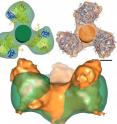HIV protein unveils vaccine target
An international study headed by a UC Davis scientist describes how a component of a potential HIV vaccine opens like a flower, undergoing one of the most dramatic protein rearrangements yet observed in nature. The finding could reveal new targets for vaccines to prevent HIV infection and AIDS. A paper describing the work was published online this week in the journal Proceedings of the National Academy of Sciences. In the new study, researchers from the U.S., Sweden and France explored the structure and behavior of the HIV envelope protein complex, which could potentially serve as a component of a vaccine aimed at eliciting the human immune system to generate antibodies against HIV.
"By opening up these less exposed regions, we might be able to raise more broadly cross-reactive antibodies to HIV," said R. Holland Cheng, professor of molecular and cellular biology at UC Davis and senior author of the study.
HIV infects a type of white blood cell called the CD4 T cell, weakening the immune system and leading to AIDS. HIV attaches to these cells through the envelope protein complex, which is made up of three gp120 proteins and three gp41 proteins, Cheng said.
First, the gp120 protein attaches to a CD4 protein on the victim cell's membrane. Then it uses gp41 to punch a hole through the membrane.
UC Davis graduate student Carlos Moscoso and project scientist Li Xing, working in Cheng's laboratory, used a cryoelectron microscope to study the structure of the complex and how it changes when it is exposed to a piece of the CD4 protein. A cryoelectron microscope derives three-dimensional images of complex protein structures from samples frozen in liquid nitrogen.
They found that when the HIV protein complex attaches to a CD4 protein, it rotates and flattens, exposing more of the gp41 proteins in the middle — probably allowing the gp41 protein to get closer to the cell membrane so it can lock on.
It also potentially exposes an area of the virus that would be vulnerable to attack by the immune system, Cheng said. If a person were vaccinated and had antibodies to such a protein region, they might be able to stop the virus at the point of invading the CD4 T cell.
The gp120 protein itself varies considerably between strains, so it has been difficult to make an effective vaccine against it. But these hidden protein regions vary less between different strains of HIV, Cheng said.
Cheng's group is part of the HIV Research and Design consortium formed by the National Institutes of Health to pursue new targets for HIV vaccines. In future work, the consortium plans to test potent antibodies from HIV-positive people who have survived without developing AIDS to see if the antibodies recognize the new potential vaccine targets.
The envelope protein complex was prepared by Novartis Diagnostics and Vaccines Inc. of Cambridge, Mass.
Source: University of California - Davis
Articles on the same topic
- Study identifies promising target for AIDS vaccineThu, 31 Mar 2011, 21:52:42 UTC
Other sources
- Study Identifies Promising Target for AIDS Vaccinefrom Newswise - ScinewsFri, 1 Apr 2011, 1:30:50 UTC
- Promising target for AIDS vaccinefrom Science DailyFri, 1 Apr 2011, 1:30:21 UTC
- The improbable appears promisingfrom Harvard ScienceThu, 31 Mar 2011, 23:00:36 UTC
- Study identifies promising target for AIDS vaccinefrom PhysorgThu, 31 Mar 2011, 22:30:50 UTC
- HIV protein unveils vaccine targetfrom PhysorgThu, 31 Mar 2011, 12:32:48 UTC
